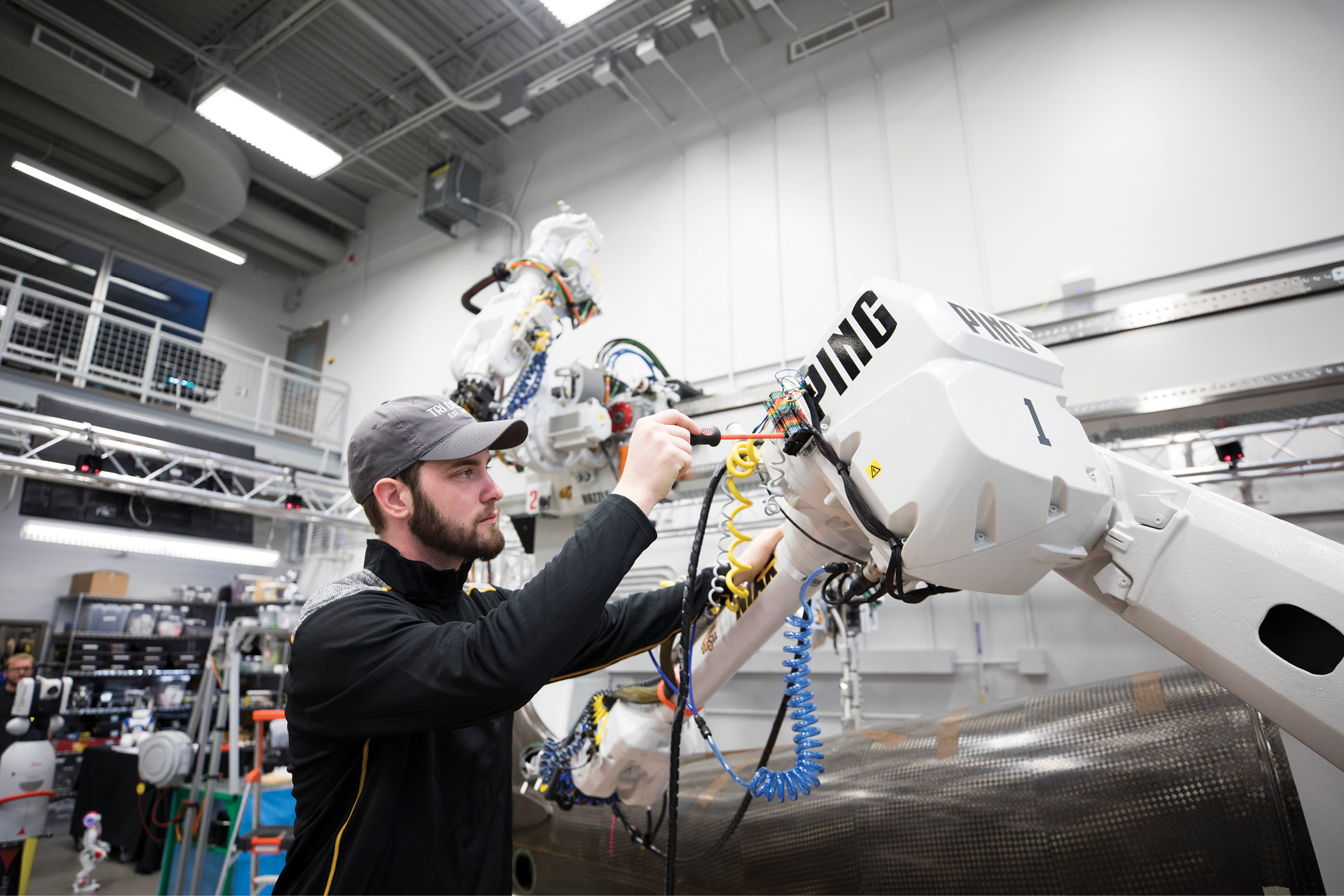Pure Imagination Studios’ portfolio of projects features many of Hollywood’s most recognizable names: DreamWorks, Disney, FOX, The LEGO Group, Marvel Entertainment, Warner Bros. and Netflix, to name a few. Yet the award-winning independent studio’s most recent undertaking goes outside its usual pursuits.
“We are establishing the world’s first-of-its-kind spatial computing studio and training facility. It is an innovation hub at the forefront of the fourth industrial revolution,” said Pure Imagination Founder Joshua Wexler in a press release.
The studio has partnered with the State of Kansas, Kansas State University Salina and the Salina Airport Authority for this project, which will be located on the university’s campus.
Backed by a $41 million investment — the largest ever allocated in K-State Salina’s infrastructure — the upcoming facility, dubbed the Kansas Advanced Immersive Research for Emerging Systems (K-AIRES), will span 58,000 sq. ft. and feature advanced equipment and immersive technologies for education and research. Pure Imagination and its partners aim to transform the learning experience for various industries, including aerospace, manufacturing, entertainment and defense.
This project is set to create 100 new jobs in the area and act as a catalyst for further job creation, aiming to entice corporations seeking the pipeline of skilled workers generated by this resource.
“Our mission is to ignite visionary storytellers spanning diverse sectors. Together, we aspire to reshape the narrative of human progress, leaving an indelible legacy of positive change. This transformative technology is set to revolutionize every facet of industry, from education and storytelling to public safety,” said Wexler. “The choice to anchor the studio at K-State Salina stems from the institution’s thriving ecosystem and the state’s resolute commitment to challenging the status quo. This partnership stands as an investment in the local community and economy with the potential to propel Kansas to the forefront of the spatial computing industry.”
Innovations that Make an Impact
This level of interest from investors isn’t new to Kansas’ higher education system.
While most know the University of Kansas for its basketball prowess, its researchers boast an equally impressive resume of wins. With nearly $300 million in research expenditures, KU is at the forefront of technological innovation, inciting advancements in a variety of industries.
In April, the U.S. Department of Energy’s Solar Energy Technologies Office awarded KU’s Center for Environmentally Beneficial Catalysis (CEBC) a $1.3 million grant. In collaboration with the Idaho National Laboratory and First Solar Inc., KU researchers will utilize this funding to develop new processes to remove the outer layers of solar panels once they no longer work. The system created will be able to divide out the valuable recyclable materials using methods that maximize the quantity and quality of recovered materials.

Robotics lab at Wichita State University
Photo courtesy of Wichita State University
“Efficient recycling of solar panels will be essential as the industry grows, to ensure the availability of critical materials, minimize waste and limit costs,” said Bala Subramaniam, CEBC director and KU’s Dan F. Servey Distinguished Professor of Chemical & Petroleum Engineering. “Solving this problem now is essential to avoid the type and scale of pollution that we currently face with waste plastics. This project is an example of the forward-thinking research that the KU CEBC and its collaborators undertake to promote the sustainability of our planet.”
Through one of its latest ventures, Research Rising, KU is expanding it’s efforts to combat global challenges. The five-year initiative is investing more than $12 million in interdisciplinary projects that address critical issues under five research themes: Development Across the Lifespan, Earth, Energy + Environment, Human Experience in the Digital Age, Molecules + Medicines and Safety + Security.
In June 2022, four projects were selected to participate: Securing Our Worlds: Physical, Digital, Social focuses on solving problems related to safety and security; Big Data for Drug Discovery works to integrate biotechnologies that collect large amounts of data to better understand diseases; Growing KU’s Interdisciplinary Strengths in Genomics intends to uncover the secrets in genomes for health innovation and sustainable development purposes; and Advancing Intellectual and Developmental Disabilities Research at KU strives to enhance the university’s internally renown intellectual and developmental disabilities (IDD) research programs.
WSU Takes Off
Located about an hour south of Salina, Wichita State University’s National Institute for Aviation Research (NIAR), among 14 other recipients, was awarded a $50 million grant from NASA in March 2023.
“This transformative technology is set to revolutionize every facet of industry, from education and storytelling to public safety.”
— Joshua Wexler, Founder, Pure Imagination Studios
The funding stems from NASA’s Hi-Rate Composite Aircraft Manufacturing (HiCAM) project, which strives to increase the production rate of composite structures within the U.S., contributing to the country’s goal to reduce carbon emissions in aviation.
This project concentrates on three key manufacturing concepts: next-generation thermosets, resin-infused composites and thermoplastic composites. The newly awarded funds will support the assessment and development of these concepts on a smaller scale, encompassing experiments in material processing, assembly techniques, inspection methods and structural performance.
WSU has received several awards from NASA over the last few years, the most recent being in November. WSU was selected as one of three university-led teams to receive funding for a two-year research term exploring aviation maintenance challenges related to NASA’s strategic vision for aeronautics.
The awardees, including Clemson University and University of California, Davis, will research new maintenance techniques and procedures and discover how aviation maintenance programs at technical schools could alter and expand their curriculum to include these new practices.
According to the National Science Foundation’s most recent Higher Education Research and Development Survey, which displays data from FY2021, WSU ranked among the top 20 universities in the U.S. in engineering research and development funding. In total aerospace R&D expenditures, WSU ranked third with $153 million and first in industry-funded aerospace R&D with a total of $75 million.

